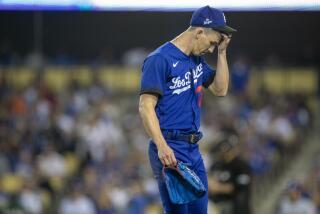PERSONAL HEALTH : Undergo Physical Therapy <i> Before</i> Injury
- Share via
Sports stars discovered it first: The more you use physical therapy as preventive maintenance, the less time you’ll rack up in rehab.
This new approach to physical therapy has such a common-sense premise--identify weak muscles and build them up before they rip or strain--that everyone wonders what took so long.
Preventive physical therapy is gaining favor with professional and amateur athletes as well as adults who switch or start exercise routines. The cost of an evaluation to pinpoint weaknesses can be a good investment in reducing injury and downtime, they say.
*
The Mix: By far, repair and rehabilitation still occupy most of a physical therapist’s day, says Robert Forster, a physical therapist in Santa Monica who specializes in sports and spinal care and treats many well-known athletes. About 20% of his practice is geared toward prevention, the other 80% toward more traditional physical therapy. “But preventive PT was nonexistent 10 or 15 years ago,” he says.
*
The Athlete Screen: Growing numbers of sports teams are sending high school athletes for preseason physical-therapy exams, says Michael G. Fortanasce, a physical therapist and director of Fortanasce & Associates Physical Therapy/Sports Medicine Center in Arcadia, which provides mass screenings for high schools.
The exam is brief but telling. Within about 30 minutes, a physical therapist evaluates the shoulders, spine, hips, knees and ankles. “We are looking for a lack of flexibility, a lack of joint movement or too much movement,” Fortanasce says. “We’re looking also for muscle strength.”
The main problems found are muscle weakness and lack of joint mobility. The latter usually stems from prior injury, but could be the result of insufficient flexibility, he says. Adolescent boys, in particular, have tight hamstring muscles, and can reduce injury risk simply by stretching them regularly.
At the conclusion, recommendations are given to the school’s athletic trainer, who takes over from there. For instance, an athlete with a knee-tracking problem would be given specific instructions on increasing quadriceps muscle strength, which is crucial to proper knee extension.
“About one-third of athletes get through without problems,” Fortanasce says, “while two-thirds show minor to major weaknesses or injuries.”
Even athletes without obvious problems can target certain muscles for strengthening to minimize injury risk. A baseball player, for instance, should concentrate on strengthening and stretching the muscles of the rotator cuff in the shoulder.
*
The Adult Screen: Adults entering a fitness program or those switching activities can ward off injuries with a similar evaluation.
Suppose a burned-out middle-age runner decides to take up tennis. “He’d be likely to have weak rotator-cuff muscles and weak upper-back extensor muscles,” Fortanasce says, citing runners’ tendency to be better developed in their lower body than upper. “They also tend to carry their upper body flexed forward, while tennis players need to open up their shoulders to execute a proper serve.” The prescription in this case would involve at-home exercises to strengthen the back and rotator-cuff muscles.
Adults who exercise faithfully but have repeated injuries can also benefit from a physical-therapy evaluation, helping to determine whether weak muscles or improper form puts them on the injured list.
*
The Costs: Fees for physical-therapy evaluations vary, with mass screenings less expensive than individual consultations. Around Los Angeles, the range for a prevention-oriented screening is $15 to $100. Besides providing the evaluation, most physical therapists will give printed or verbal instructions. The more comprehensive exams also include demonstrations of specific exercises and observation of the client for proper form.
*
The Payoff: Thanks to preventive PT, athletic injuries were down by 29% during the 1992 sports season at Maranatha High School in Sierra Madre, says athletic trainer Cheryl Herlacher, who had her athletes evaluated before they played. The severity of injuries in athletes who followed strengthening and stretching recommendations was reduced by more than half.
Coach Bob Kersee swears by preventive PT, convinced it contributes to the success of his wife, Jackie Joyner-Kersee, who won the Olympic gold for the heptathlon in 1988 and often undergoes physical therapy twice a week. “The combination of strength work, weight work and stretching in physical therapy can help prevent the muscles from breaking down,” he says.
*
Finding a Good PT: Physical therapists are licensed by the state in which they practice. Their education includes at least four to six years of study after high school, says the American Physical Therapy Assn. Courses include basic and applied science, research and hands-on practical experience.
Therapists may also be certified by the American Board of Physical Therapy Specialties in seven areas: sports, orthopedics, geriatrics, pediatrics, cardiopulmonary, neurology and clinical electrophysiology.


